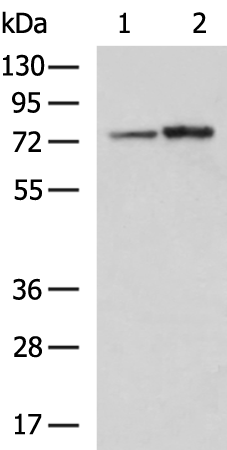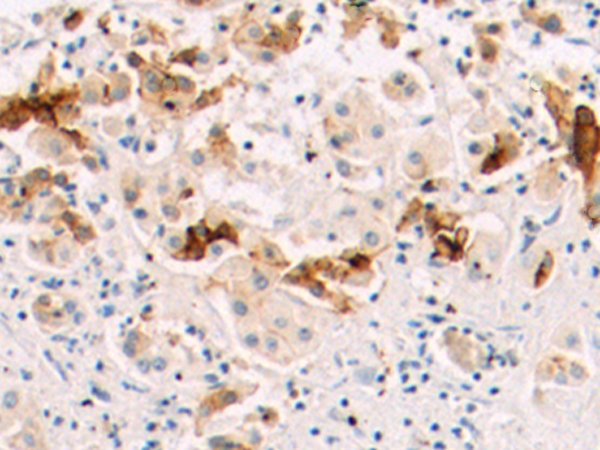

| WB | 1/500-1/2000 | Human,Mouse,Rat |
| IF | 咨询技术 | Human,Mouse,Rat |
| IHC | 1/50-1/100 | Human,Mouse,Rat |
| ICC | 技术咨询 | Human,Mouse,Rat |
| FCM | 咨询技术 | Human,Mouse,Rat |
| Elisa | 1/5000-1/10000 | Human,Mouse,Rat |
| Aliases | CANPX; CAPNX; CalpM; DJ914P14.1 |
| WB Predicted band size | 75 kDa |
| Host/Isotype | Rabbit IgG |
| Antibody Type | Primary antibody |
| Storage | Store at 4°C short term. Aliquot and store at -20°C long term. Avoid freeze/thaw cycles. |
| Species Reactivity | Human, Mouse, Rat |
| Immunogen | Fusion protein of human CAPN6 |
| Formulation | Purified antibody in PBS with 0.05% sodium azide and 50% glycerol. |
+ +
以下是3篇与CAPN6抗体相关的文献摘要概览,供参考:
---
1. **文献名称**: "Calpain-6 (CAPN6) is required for cell motility in human villous trophoblasts"
**作者**: Hiroshi Yamamoto et al.
**摘要**: 该研究利用特异性CAPN6抗体,发现其在人类胎盘绒毛滋养层细胞的细胞骨架重组中起关键作用,敲低CAPN6会抑制细胞迁移能力,提示其在胚胎发育中的功能。
---
2. **文献名称**: "CAPN6 promotes tumor progression by inhibiting tumor cell apoptosis in hepatocellular carcinoma"
**作者**: Li Y et al.
**摘要**: 通过Western blot和免疫组化(使用CAPN6抗体)证实,CAPN6在肝癌组织中高表达,并通过抑制凋亡相关通路促进肿瘤生长,可能成为肝癌治疗潜在靶点。
---
3. **文献名称**: "Calpain-6 regulates microtubule remodeling during cytoskeletal development"
**作者**: Smith A et al.
**摘要**: 研究通过免疫荧光(CAPN6抗体标记)发现,CAPN6参与微管动态调控,影响神经元轴突形成,为神经发育异常相关疾病提供机制解释。
---
如需具体文献链接或补充其他方向(如疾病机制、抗体开发),可进一步说明。
**Background of CAPN6 Antibody**
CAPN6 (Calpain 6) belongs to the calpain family of calcium-dependent cysteine proteases, which regulate diverse cellular processes, including cytoskeletal remodeling, apoptosis, and signal transduction. Unlike most calpains, CAPN6 lacks critical catalytic residues, rendering it proteolytically inactive. It is thought to function as a regulatory molecule, potentially through interactions with other proteins or pathways. CAPN6 is highly expressed during embryonic development, particularly in the nervous system and skeletal muscle, suggesting roles in cell migration, differentiation, and tissue morphogenesis.
Aberrant CAPN6 expression has been linked to diseases such as cancers (e.g., sarcomas, neuroblastoma) and neurological disorders. Overexpression in tumors correlates with aggressive phenotypes, metastasis, and poor prognosis, implicating it as a potential therapeutic target. CAPN6 antibodies are essential tools for studying its expression, localization, and mechanistic roles. These antibodies enable techniques like Western blotting, immunohistochemistry, and immunofluorescence, aiding research into its physiological and pathological functions. Commercial CAPN6 antibodies are often validated for specificity using knock-down or knock-out models, ensuring reliability in experimental settings. Ongoing research aims to clarify CAPN6's unique regulatory mechanisms and therapeutic relevance in disease contexts.
×